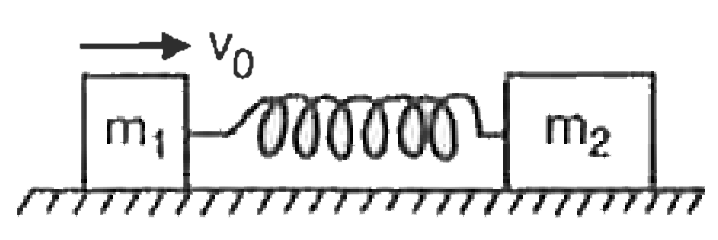A ball of mass m=50g is suspended by a weightless spring with stiffness x=20.0N/m. Due to external vertical harmonic force with frequency ω=25.0s−1 the ball performs steady − state oscillations with amplitude a=1.3cm. In this case the displacement of the ball lags in phase behind the external force by φ=34π. Find :
(a) the quality factor of the given oscillator ,
(b) the work performed by the external force during one oscillation period.
In the formula x=acos(ωt−φ)
we have a=F0m1√(ω20−ω2)2+4β2ω2
tanφ=2βωω20−ω2
Thus β=(ω20−ω2)tanφ2ω
Hence ω0=√K/m=20s−1
and (a) the quality factor
Q=πβT=√ω20−β2β=12
⎷4ω2ω20(ω20−ω2)2tan2φ−1=2.17
(b) work done is A=πaF0sinφ
=πma2√(ω20−ω2)2+4β2ω2sinφ=πma2×2βω
=πma2(ω20−ω2)tanφ=6mJ
Topper's Solved these Questions
- BOOK - IE IRODOV, LA SENA & SS KROTOVCHAPTER - OSCILLATIONS AND WAVESEXERCISE - Electric Oscillations56videos
OSCILLATIONS AND WAVES
- BOOK - IE IRODOV, LA SENA & SS KROTOVCHAPTER - OSCILLATIONS AND WAVESEXERCISE - Elastic Waves39videos
OSCILLATIONS AND WAVES
- BOOK - IE IRODOV, LA SENA & SS KROTOVCHAPTER - OPTICSEXERCISE - Exercise2videos
OPTICS
- BOOK - IE IRODOV, LA SENA & SS KROTOVCHAPTER - PHYSICAL FUNDAMENTALS OF MECHANICSEXERCISE - Relativistic Mechanics49videos
PHYSICAL FUNDAMENTALS OF MECHANICS
Similar Questions
Find the quality factor of the oscillator whose displacement amplitude decreases η=2.0 times every n=110 oscillation.
View SolutionDue to the external vertical force Fx=F0cosωt a body suspended by a spring performs forced steady − state oscillations according to the lawx=acos(ωt−φ). Find the work performed by the force F during one oscillation period.
View Solution
Knowledge Check
- Question 1 - Select One
When a mass of 1 kg is suspended from a spring, it is stretched by 0.4m. A mass of 0.25 kg is suspended from the spring and the spring is allowed to oscillate. If g=10m/s2, then its period of oscillation will be
A0.5 secB0.4 secC0.628 secD1.5 sec - Question 2 - Select One
A ball hung from a vertical spring oscillates in simple harmonic motion with an angular frequency of 2.6 rad/s and an amplitude of 0.075m. What is the maximum acceleration of the ball?
A0.13m/s2B0.20m/s2C0.51m/s2D2.6m/s2
A ball of mass m when suspended by a spring stretches the latter by Δl. Due to external vertical lforce varying according to a harmonic law with amplitude F0 the ball performs forced oscillations. The logarighmic damping decrement if equal to λ. Neglecting the mass the spring, find the angular frequency of the external force at which the displacemetn amplitude of the ball is maximum. What is the magnitude of that amplitude ?
View SolutionA body of mass 0.5 kg is suspended by a weightless spring of force constant 500 Nm−1. Another body of mass 0.1 kg moving vertically upwards with velocity of 5 ms−1 hits the suspended body and gets embeded into the suspended body. What will be the frequency of oscillation ?
View SolutionA ball of mass m suspended by a weightless spring can perform vertical oscillations with damping coefficient β. The natural oscillation frequency is equal to ω0. Due to the external vertical force varying as F=F0cosωt the ball performs steady − state harmonic oscillations. Find :
(a) the mean power (:P:) , develocped by the force F. averaged over one oscillations perod,
(b) the frequency ω of the force F at which (:P:) is maximum, what is (:P:)max equal to ?View SolutionA body of mass 1kg is suspended from a weightless spring having force constant 600N/m. Another body of mass 0.5kg moving vertically upward hits the suspended body with a velocity of 3.0m/s and get embedded in it. Find the frequency of oscillations and amplitude of motion.
View SolutionA body of mass 1.0 kg is suspended from a weightless spring having force constant 600Nm−1. Another body of mass 0.5 kg moving vertically upwards hits the suspended body with a velocity of 3.0ms−1 and gets embedded in it. Find the frequency of oscillations and amplitude of motion.
View SolutionTwo bodies with masses m1 = 1kg and m2= 2kg are connected by a spring of force constant k=24Nm−1. The left ball is imparted an initial velocity v0=12 cm/s. Find (a) the frequency of the oscillations (b) the energy and the amplitude of the osciallations.
 View Solution
View Solution

